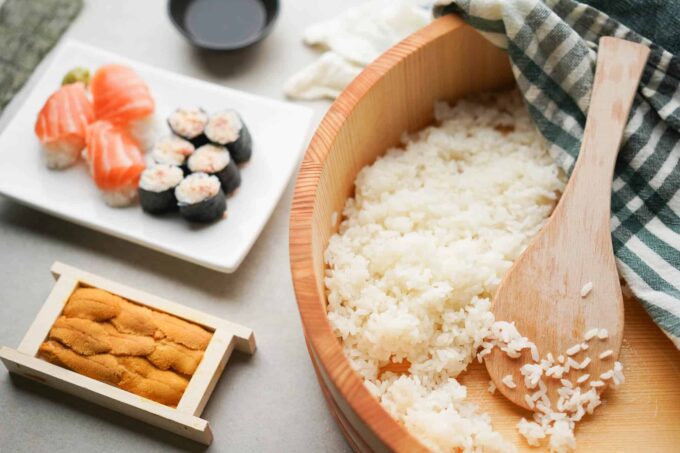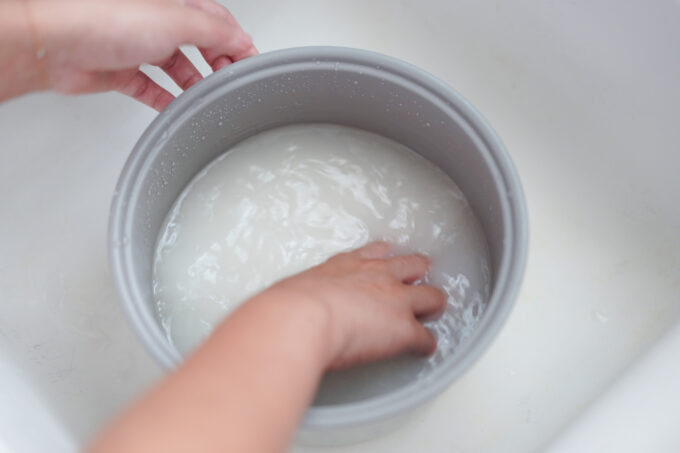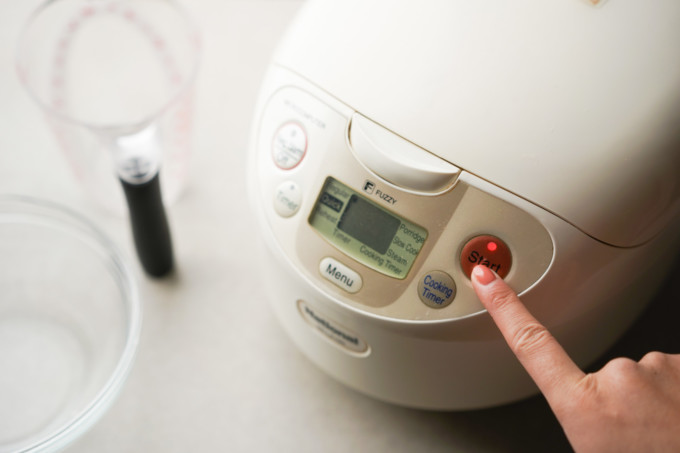This sumeshi (or vinegared sushi rice) recipe will give you perfectly plump and seasoned sushi rice that can be topped with fresh slices of fish, in temaki (handrolls), California rolls, or spicy tuna rolls. This recipe will take you from the very beginning of making rice in a rice cooker to mixing flavorful seasonings properly over plump rice granules using a traditional hangiri (or other more accessible tools at home). You can start sushi rice in a rice cooker, but need to finish seasoning it outside of the cooker. Let’s get started!

Type of rice cooker to use
While there are options of microwaving, stovetop cooking, or steaming rice that is also PFA-free, but using a rice cooker is still the easiest, fastest, and most hands-off with perfect results. To make sushi rice, I prefer using a rice cooker because it’s an easy, hands-off method to get perfectly plump and moist grains of rice without worrying about boiling water or overcooking it. And you know the results will turn out the same every time as long as you accurately weigh the rice and water.
Types rice to use

Traditionally, sushi rice is made using white short-grain rice but in a pinch, you can also use white medium-grain rice. Rice is made up of two different starches: amylose and amylopectin. The higher amounts of amylopectin in a grain of rice, the stickier its texture will be after it’s cooked.
You want to steer clear of long-grain rice because you need a stickier and starchier consistency for sushi rice. Short grain rice (and medium grain rice) has very high amounts of amylopectin and is perfect for making sushi rice.
Some of my favorite brands to use for sushi rice are Tamaki Gold short-grain rice, Koda Farms Kokuho Rice (medium grain), and Koshihikari short-grain rice. I like to buy short-grain rice from any local Asian grocery store like Mitsuwa or 99 Ranch.
Rice to water ratio for sushi rice in a rice cooker

To get perfect sushi rice consistency, stick with an easy-to-remember rice to water ratio of 1:1. That means for every one cup of sushi rice, you need to add one cup of filtered water. If you want to make more than one cup of rice, follow the same ratio:
- 2 servings: 1 cup of short-grain or medium grain rice, 8 fluid ounces of filtered water
- 4 servings: 2 cups of short-grain or medium grain rice, 16 fluid ounces of filtered water
For all the short-grain rice brands we’ve tried, the above ratio of 1:1 is the same, however, if you need help troubleshooting your rice consistency, you may need to adjust the amount of water for future batches.
If your rice is too hard, you need to add more water. I like to add water in 2 tablespoon increments and microwave the rice for 30 seconds (covered with a towel) until it’s plump and soft in texture. If your rice is too soft, unfortunately, you need to restart from the beginning and reduce the amount of water by 2 tablespoons or more depending on how wet your current rice consistency is.
Do you need to wash sushi rice?

It’s super important to always wash any rice you make before cooking and most importantly sushi rice. I wash my sushi rice multiple times until the water is completely clear. Washing rice removes excess debris and starch from the outside of the grains. You want your sushi rice to be plump and ready for seasoning, not extra sticky or mushy because of the excess starch.
Sushi rice seasoning

If you’ve ever had sushi before you might notice that the rice is seasoned–it doesn’t just taste like plain white rice but is coated with a sweet, salty, and slightly vinegared seasoning. For this recipe, we use a basic recipe of three ingredients: rice vinegar, white granulated sugar, and kosher salt with a customizable ratio of 1:3:3.
This ratio for seasoning will give you a slightly sweet and vinegary flavor, but if you prefer to have more tang in your sumeshi, you can add more rice vinegar in one teaspoon increments. If you like a sweeter flavor, you can add more sugar in one teaspoon increments.
Rice vinegar can be purchased at your local grocery store these days, but make sure it’s labeled rice vinegar and not “seasoned rice vinegar” because the latter has added sugar, which we don’t need.
The easiest way to make the seasoning is to add everything in a microwavable bowl and heat for about 20-30 seconds until all the ingredients have dissolved. You can also do this over the stove on low heat, but it’s much faster and easier in a microwave.
Recap: making sushi rice in a rice cooker

- Measure out all the rice and water with a kitchen scale or the appropriate dry and liquid measuring cups–this will help get the most accurate measurements aka fool-proof cooking! Use a strainer to help rinse out all the excess starch and debris on the rice. If you don’t rinse the rice, you could end up with too much starch and overly mushy or goopy consistency.
- Follow the instructions for your rice cooker. I cook short-grain rice on the normal setting and just press start. After it’s finished cooking, I like to let the rice rest in the rice cooker with the lid closed for about 5 minutes to remove any excess moisture. I open the lid and turn off any warming setting to prevent the rice from overcooking.
- Splash water all around the inside of the hangiri, making sure all sides of the hangiri are saturated with water. Pour out the remaining water in the sink.
- Transfer the hot rice into the hangiri (if you don’t have a hangiri, you can also use a large, shallow mixing bowl and a flat spatula). Pour the seasoning over the rice as evenly as possible and use your rice paddle as a way to distribute the rice.
- Use your rice paddle to gently slice into the rice to begin to mix the seasoning throughout the rice grains. Some people like to use a quick, but gentle flicking motion to cut through the clumps of the rice and mix the seasoning around. Don’t try to push down the rice because you’ll mush them instead of mixing them.
- You want separated grains of rice that are fully coated with the seasoning. After thoroughly seasoning the rice, level out the rice and cover it with a damp towel to prevent the rice from drying out or getting cold while you’re assembling your sushi. You want the rice to be slightly above room temperature, but not cold.
- Use sumeshi for your next California roll recipe, spicy tuna roll recipe (w/ kewpie & sriracha), or how to make hand rolls (temaki sushi recipe).

Sushi Rice in Rice Cooker
Ingredients
- 2 c (400 g) short grain rice or medium-grain rice
- tap water for rinsing rice
- 2 c (16 fl oz) filtered water
- 2 tbsp (32.6 g) rice vinegar
- 2 tbsp (30 g) sugar
- 1 tsp (3.5 g) kosher salt
Equipment Used
- Strainer
- Kitchen scale or measuring cups and spoons
- small mixing bowl
- rice paddle (or flat spatula)
- hangiri (or large, shallow mixing bowl)
- towel
Instructions
COOKING RICE IN A RICE COOKER
- Measure the rice using a scale or measuring cups. Transfer the rice into a strainer and rinse under running water. Use your hands to move the rice around gently to make sure all the grains are cleaned. Continue to rinse the rice until the water runs clear.
- Transfer the rice into the rice chamber and add the filtered water over the rice. Distribute the rice so it's level with the water.
- Close the lid and follow your rice cooker’s instructions. My rice cooker has a basic “rice” setting that I choose and press start. After the rice has finished cooking, I leave it in the chamber with the lid closed for about 5 minutes to allow the grains to soak up any excess moisture.
VINEGAR MIXTURE
- When your rice is finished cooking, add the ingredients of the rice seasoning in a microwave safe bowl and mix with a fork or spoon.
- Cook in the microwave for 30 seconds and then stir to combine. If there are still granules of sugar or salt, continue to cook for another 15 seconds and stir again until it’s fully dissolved.
COMBINING RICE + VINEGAR MIXTURE
- Pour water into the hangiri and swirl it around to make sure water coats all the wood inside. Pour any excess water out.
- Transfer the rice into the hangiri and pour the rice seasoning over the rice evenly. If you don't have a hangiri, you can also use a large, shallow mixing bowl and a flat spatula in place of a rice paddle.
- Take your rice paddle and gently slice into the rice at 45 degree angle to help move around the seasoning in the rice. Turn the hangiri counter clockwise as you continue to slice into the rice and mix the seasoning. DO not try to mush the rice together otherwise the rice will clump and become too sticky. You want to mix the rice thoroughly before it cools down.
- After you’ve evenly coated the grains with the seasoning, cover the rice with a damp towel to prevent it from drying out. Use as soon as possible.
















Horrible should make it easer like cups… So stupid
Hey Matt, there are measurements in cups there as well as weight–feel free to use whichever you like.
Wow, you get provided a free recipe, no “thank-you”, just bitch and moan, that’s a dick move Matt, so entitled.
Thanks for the recipe guys, ignore Matt, he was badly raised.
Thank you for your recipe. Can I make sushi rice the night before? If yes, what’s the best way to store it.
If not, what’s the ideal temperature before of the rice before making a sushi roll? I would like to make your califiornia roll recipe to send with my child to school as their lunch.
Hi Dallas, I like the rice warm but not too steamy, so it doesn’t sog up the seaweed sheets too much.